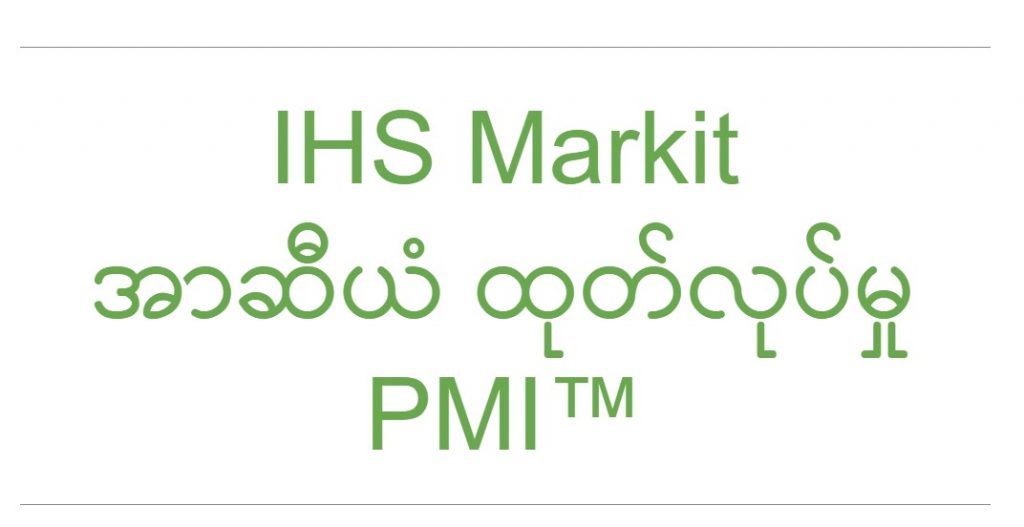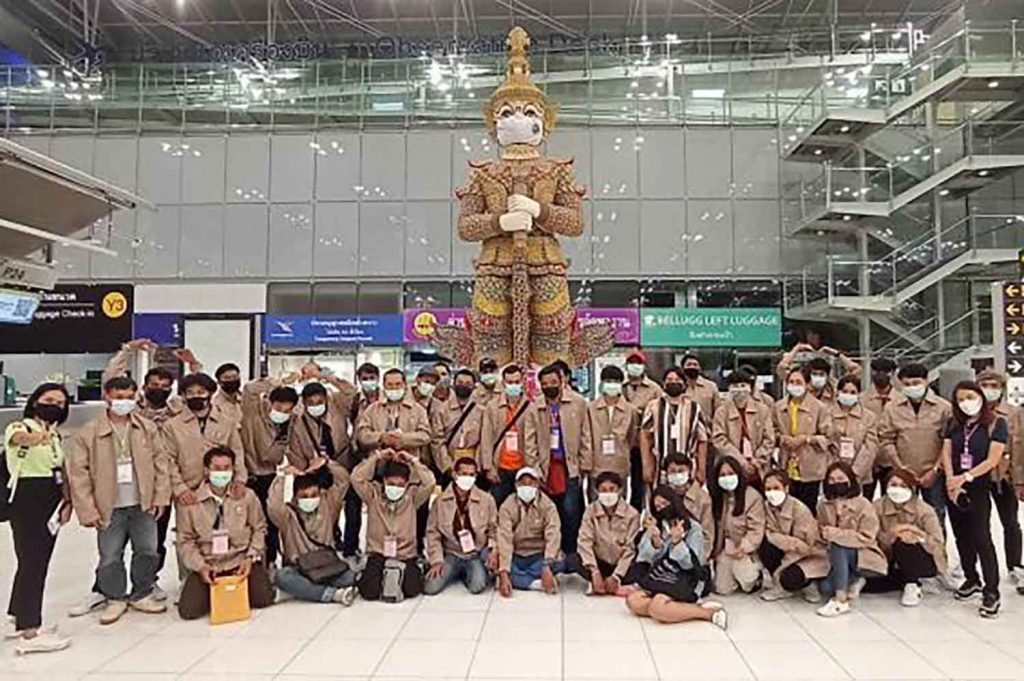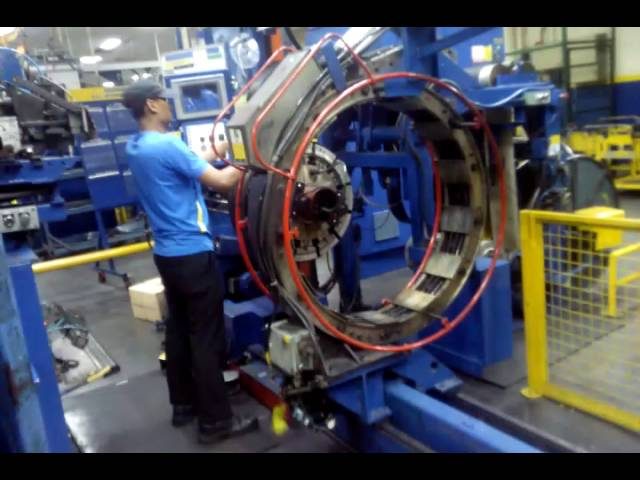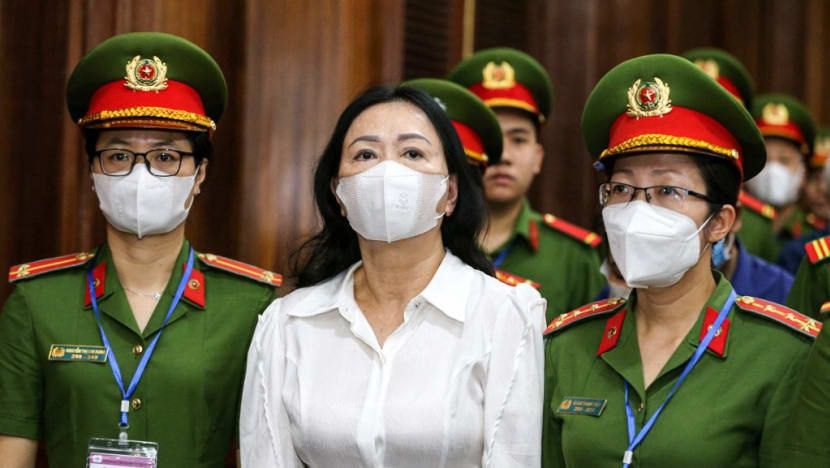ထုတ်လုပ်ရေး အခြေအနေများ ဇန်နဝါရီလတွင် စံချိန်တင်နီးပါး ရှေ့ဆက် တိုးတက်လာ
IHS Markitမှ ၂၀၂၂ ဖေဖော်ဝါရီလဆန်းတွင် ထုတ်ပြန်သော အာဆီယံ ထုတ်လုပ်မှု PMI™ သတင်းထုတ်ပြန်ချက်တွင် ထုတ်လုပ်ရေး အခြေအနေများ ဇန်နဝါရီလတွင် စံချိန်တင်နီးပါး ရှေ့ဆက် တိုးတက်လာကြောင်း ဖော်ပြထားပါသည်။
အဓိက တွေ့ရှိချက်များ
- PMI သည် စစ်တမ်း အမြင့်ဆုံးအနီး ၅၂.၇ တွင် မပြောင်းမလဲရှိနေခြင်း
- ထုတ်လုပ်မှုမှာ အားကောင်းစွာ တိုးလာခဲ့သော်လည်း တိုးတက်မှုနှုန်း အားပျော့လာခြင်း
- ကုန်ထုတ်စွမ်းအားများအပေါ် ဖိအားပေးမှုများ စံချိန်တင်ရှိနေသည့်ကြားမှ ကုမ္ပဏီများက ဝန်ထမ်းများကို ပထမဆုံးအကြိမ်အဖြစ် ထပ်တိုးခန့်လာကြခြင်း
ဒေတာကို ၂၀၂၂ ခုနှစ် ဇန်နဝါရီ ၁၂-၂၅ ရက်များတွင် စုစည်းခဲ့သည်။
နောက်ဆုံးရ အာဆီယံ ထုတ်လုပ်မှု ဝယ်ယူရေး မန်နေဂျာများ၏ အညွှန်းကိန်း (PMI™) ဒေတာအရ အာဆီယံ ထုတ်လုပ်မှုကဏ္ဍ၏ လုပ်ငန်း အခြေအနေများမှာ ဇန်နဝါရီလတွင် ရှေ့ဆက်ပြီး စံချိန်တင်နီးပါး တိုးတက်လာခဲ့သည်။ ထုတ်လုပ်မှုမှာ တစ်လချင်း ယှဉ်ကြည့်လျှင် မသိမသာ အားပျော့သွားသော်လည်း အားကောင်းမြဲ ကောင်းနေပြီး မှာယူခဲ့ကြသည့် အော်ဒါ ပမာဏတိုးလာသည့်နှုန်းမှာ နှစ်လအတွင်း အမြင့်ဆုံး ဖြစ်လာသည်။ သို့ဖြစ်၍ ကုန်ထုတ်စွမ်းအားများအပေါ်သို့ ဖိအားပေးမှုများ ပိုပြင်းထန်လာခဲ့ရာ အာဆီယံ ထုတ်လုပ်သူတို့ လက်ထဲတွင် ကျန်ရှိသော လက်ကျန်အလုပ်များမှာ စစ်တမ်းသမိုင်းအတွင်း အမတ်စောက်ဆုံး မြင့်တက်သွားခဲ့သည်။ အကျိုးဆက်အဖြစ် ကုမ္ပဏီများသည် မိမိတို့၏ အလုပ်သမား ဦးရေကို သုံးနှစ်နီးပါးအတွင်းမှာ ပထမအကြိမ် တိုးခန့်ခဲ့ကြရသည်။
အဓိကအကျဆုံး အညွှန်းကိန်း PMI သည် ဇန်နဝါရီလအတွင်း ဒီဇင်ဘာလ၏ ၅၂.၇ အတိုင်း မပြောင်းမလဲ ရှိနေခြင်းက အာဆီယံ ထုတ်လုပ်မှုကဏ္ဍ၏ အခြေအနေ လေးလမြောက် ဆက်တိုက် တိုးတက်လာနေကြောင်းနှင့် ၁၀-နှစ် နီးပါး စစ်တမ်း သမိုင်းထဲတွင် ပူးတွဲဒုတိယ အမြင့်ဆုံး ဖြစ်ကြောင်းကို အချက်ပြနေသည်။

စင်ကာပူနိုင်ငံသည် အာဆီယံ အဖွဲ့ဝင် ခုနစ်နိုင်ငံအကြားတွင် ထုတ်လုပ်မှု အခြေအနေများ အများဆုံး တိုးတက်လာခဲ့သည့် နိုင်ငံအဖြစ် ဇန်နဝါရီလတွင် ထပ်ပြီး မှတ်တမ်းတင်လိုက်သည်။ ၅၈.၀ တွင် ရှိနေသည့် အဓိက အကျဆုံး PMI အညွှန်းကိန်းမှာ ဒီဇင်ဘာလ၏ စံချိန်တင်နီးပါး နှုန်းအတိုင်း မပြောင်းမလဲ ရှိနေသည်။
ဤအတောအတွင်း ဗီယက်နမ်၏ အဓိက အညွှန်းကိန်း (၅၃.၇) က ဇန်နဝါရီလတွင် လွန်ခဲ့သည့် ဧပြီလမှစပြီး အားအကောင်းဆုံး ဦးမော့မှုကို ညွှန်ပြလိုက်ကာ တိုးတက်မှုနှုန်းမှာ ခြုံပြောရလျှင် ခိုင်မာပါသည်။
အင်ဒိုနီးရှားနိုင်ငံကပါ အားကောင်းသည့် တိုးတက်မှုကို မှတ်တမ်းတင်ဖြစ်ခဲ့ပြီး PMI မှာမူ ဗီယက်နမ်နိုင်ငံ၏ (၅၃.၇) နှင့် ထပ်တူဖြစ်သည်။
ထိုင်းနိုင်ငံ၏ ကုန်စည် ထုတ်လုပ်မှုကဏ္ဍသည် ဒီဇင်ဘာလ၏ ဒသမဂဏန်းမျှ ကျဆင်းမှု နောက်ပိုင်း အဓိက အကျဆုံး အညွှန်းကိန်း (၅၁.၇) ဖြင့် ခြုံပြောရလျှင် ဒသမဂဏန်းမျှ ဦးမော့လာမှုကို ပြသလျှက် တိုးတက်ရေးနယ်ပယ်ထဲသို့ ပြန်လည်ရောက်ရှိလာသည်။
တချိန်တည်းမှာပင် မလေးရှားနိုင်ငံတွင်း ထုတ်လုပ်မှု အခြေအနေများမှာ လေးလဆက်တိုက် တိုးတက်လာခဲ့သော်လည်း PMI (၅၀.၅) က ဒီဇင်ဘာထက် ပိုနှေးလာသည့် နှုန်းဖြစ်ပြီး ခြုံကြည့်လျှင် အသင့်အတင့်သာ ရှိပါသည်။
အခြားနိုင်ငံများကို ကြည့်လျှင် ဖိလစ်ပိုင်နိုင်ငံက ဇန်နဝါရီလတွင် လုပ်ကိုင်မှု အခြေအနေများ ထိုင်းလာကြောင်းကို အစီရင်ခံထားပြီး အဓိက အညွှန်းကိန်းမှာ ဒီဇင်ဘာလ၏ ၅၁.၈ မှ ဇန်နဝါရီလတွင် အပြောင်းအလဲမရှိ အမှတ် ၅၀.၀ သို့ နိမ့်ကျသွားသည်။
နောက်ဆုံးအဖြစ် မြန်မာနိုင်ငံသည် ၂၀၂၂ ခုနှစ်အစတွင် ထုတ်လုပ်မှု အခြေအနေများ ဆုတ်ယုတ်လာကြောင်း မှတ်တမ်းတင်ဖြစ်ခဲ့သည့် တစ်ခုတည်းသော နိုင်ငံဖြစ်သည်။ ၄၈.၅ တွင် ရှိနေသည့် PMI က ဒသမဂဏန်းမျှ ကျဆင်းမှုကို အချက်ပြနေသော်လည်း ဒီဇင်ဘာလထက် မြန်သည့်နှုန်းဖြစ်ပါသည်။

အားလုံးခြုံပြောရလျှင် အာဆီယံ ထုတ်လုပ်မှုကဏ္ဍသည် ဇန်နဝါရီလတွင် အားကောင်းစွာ ဆက်လက်တိုးတက်လာခဲ့သည်။ ထုတ်လုပ်မှုမှာ လေးလဆက်တိုက် တိုးလာခဲ့ပြီး တိုးတက်မှု နှုန်းမှာမူ မသိမသာ အားပျော့သွားခဲ့သော်လည်း မှတ်တမ်းတွင်း အများဆုံး တစ်ခု ဖြစ်နေဆဲဖြစ်သည်။ ဤအတောအတွင်း မှာယူမှု ပမာဏများမှာ အရှိန်ဖြင့် တိုးရလာခဲ့ပြီး ခြုံပြောရလျှင် အသင့်အတင့်ဖြစ်ကာ ပြည်ပတင်ပို့ရေး အော်ဒါများ ရှေ့ဆက် တိုးတိုးရလာမှု နှုန်းမှာ ၂၀၁၇ အောက်တိုဘာမှစပြီး အမတ်စောက်ဆုံး ဖြစ်လာခြင်းနှင့် တစ်စိတ်တစ်ပိုင်းသက်ဆိုင်သည်။
အကျိုးဆက်အဖြစ် အာဆီယံ ကုန်စည် ထုတ်လုပ်သူတို့ထံတွင် မပြီးဘဲ ကျန်ရစ်ခဲ့သည့် အလုပ်များမှာ ထပ်တိုးလာခဲ့ရာ စုစည်းလာမှု နှုန်းသည် မှတ်တမ်းထဲတွင် အများဆုံးဖြစ်လာသည်။ သို့ဖြစ်၍ ကုမ္ပဏီများသည် ၂၀၁၉ ခုနှစ် မေလမှစပြီး ပထမဦးဆုံးအကြိမ် မိမိတို့၏ ဝန်ထမ်း ဦးရေကို တိုးခန့်ခဲ့ကြသော်လည်း ဒသမဂဏန်းမျှသာဖြစ်သည်။
ဇန်နဝါရီ ဒေတာက ပစ္စည်းပေးသွင်းမှုဆိုင်ရာ ပြတ်တောက်မှုများကို အာဆီယံ ကုမ္ပဏီများ ဆက်လက် ရင်ဆိုင်နေရခြင်းကိုပါ ညွှန်ပြနေသည်။ ထည့်ကုန်များကို အပြီးပေးသွင်းရန် ပျမ်းမျှ ကြာမြင့်ချိန်များမှာ လွန်ခဲ့သည့် အောက်တိုဘာလမှစ၍ အကြာရှည်ဆုံး ဖြစ်လာပြီး ခြုံပြောရလျှင် သိသာလှသည်။
ဈေးနှုန်းများကို လေ့လာကြည့်လျှင် ၂၀၂၂ ခုနှစ် အဖွင့်လတွင် ငွေကြေးဖောင်းပွမှု ဖိအားများ ပြင်းထန်လျက် ကျန်ရှိနေသေးသည်။ ထည့်ကုန် ဈေးနှုန်းများဆိုင်ရာ ငွေကြေးဖောင်းပွမှုမှာ လေးလဆက်တိုက် အားပျော့လာသော်လည်း မှတ်တမ်းထဲတွင် အားအကောင်းဆုံး
တစ်ခုအဖြစ် ရှိနေလျက် အရှိန်မြင့်ပါသည်။ ကုန်ကျစရိတ် ကြီးမြင့်လာမှု၏ ဖိအားများကြောင့် ကုမ္ပဏီများက မိမိတို့၏ ရောင်းဈေးများကို ဇန်နဝါရီလတွင် ထပ်မြှင့်ခဲ့ကြရသည်။ စက်ရုံ ရောင်းဈေးများ မြင့်တက်လာမှု နှုန်းမှာ ၂၀၁၃ ခုနှစ် အောက်တိုဘာမှစပြီး အသိသာဆုံးဖြစ်သည်။
ဤအတောအတွင်း ဇန်နဝါရီလတွင် ကုန်စည်ထုတ်လုပ်သူတို့သည် လာမည့် တစ်နှစ်အတွင်း ထုတ်လုပ်မှုနှင့် ပတ်သက်ပြီး အကောင်းမြင်မြဲ မြင်နေကြသည်။ သို့သော်လည်း အိုမီခရွန်း မူကွဲ၏ ရောဂါကူးစက်မှုဆိုင်ရာ စိုးရိမ်မှုများအကြားတွင် အနာဂတ် လုပ်ဆောင်မှု အညွှန်းကိန်းသည် လွန်ခဲ့သည့် သြဂုတ်လမှစပြီး အနိမ့်ဆုံးသို့ ကျဆင်းသွားသည်။
သုံးသပ်ချက်
နောက်ဆုံး စစ်တမ်း ရလဒ်များကို သုံးသပ်ဖေါ်ပြရာတွင် IHS Markit မှ စီးပွားရေးပညာရှင် Lewis Cooper ပြောကြားသွားသည်မှာ-
"၂၀၂၂ ခုနှစ်၏ အဖွင့်လတွင် အာဆီယံ ထုတ်လုပ်ရေး အခြေအနေများမှာ ရှေ့ဆက်ပြီး အခိုင်အမာတိုးတက်လာသည်ကို မြင်နိုင်ပြီး PMI မှာ ဒီဇင်ဘာအတိုင်း မပြောင်းမလဲ ရှိနေကာ မှတ်တမ်းထဲက အမြင့်ဆုံးတစ်ခုဖြစ်သည်။ ထုတ်လုပ်မှု တိုးတက်မှု နှုန်းမှာ မသိမသာ အားပျော့လာခဲ့သည့် တိုင်အောင် အားကောင်းမြဲ ကောင်းနေချိန်တွင် အလုပ်သစ်များ မှာယူမှုနှုန်း မြင့်လာခဲ့ရာ လေးနှစ်တာအတွင်း ပြည်ပတင်ပို့ရေး အော်ဒါများ အများဆုံး ရရှိလာမှုက ပံ့ပိုးခဲ့သည့် အကြောင်းရင်း တစ်ခု ဖြစ်ပါသည်။
"တချိန်တည်းမှာပင် မပြီးဘဲ ကျန်ခဲ့သည့် အလုပ်များမှာ စံချိန်တင် အများဆုံး နှုန်းဖြင့် တိုးလာခဲ့ရာ ကုမ္ပဏီများသည် ကုန်ထုတ်စွမ်းအားကို ရှာကြံရာတွင် အခက်အခဲများ ရှိနေခြင်းကို ညွှန်ပြနေသည်။ သို့ဖြစ်၍ ကုန်စည် ထုတ်လုပ်သူတို့သည် ၂၀၁၉ ခုနှစ် မေလမှစပြီး ပထမအကြိမ် မိမိတို့၏ ဝန်ထမ်း ပမာဏကို တိုးခဲ့ကြရသော်လည်း ခြုံကြည့်လျှင် ဒသမဂဏန်းမျှသာဖြစ်သည်။
"ပစ္စည်းပေးသွင်းမှု အခြေအနေများ ဆုတ်ယုတ်လာနေသည့်တိုင်အောင် ကုန်ကျစရိတ်များ၏ ဖိအားပေးမှုများမှာ ဇန်နဝါရီလတွင် မသိမသာ လျော့နည်းသွားပြီး ကုန်ကျစရိတ်များ၏ ငွေကြေးဖောင်းပွမှု နှုန်းသည် လွန်ခဲ့သည့် စက်တင်ဘာလမှစပြီး အနည်းဆုံး ဖြစ်လာသည်။
"တိုးထုတ်လုပ်မှုကို ၂၀၂၂ ခုနှစ်သို့ ထိန်းသိမ်း ယူဆောင်ပေးနိုင်ခဲ့သော အာဆီယံ ထုတ်လုပ်မှုကဏ္ဍ၏ ခြေကုပ်မှာ ခိုင်ခန့်ပါသည်။ ဇန်နဝါရီလတွင် အိုမီခရွန်း မူကွဲဆိုင်ရာ စိုးရိမ်မှုများ ရှိနေသော်လည်း ခြုံကြည့်လျှင် ကုမ္ပဏီများသည် လာမည့် တစ်နှစ်အတွင်း ထုတ်လုပ်မှုကို အကောင်းမြင်မြဲ မြင်နေကြပြီး ထုတ်လုပ်မှုကဏ္ဍအပေါ် အိုမီခရွန်း၏ သက်ရောက်မှုမှာ အသင့်အတင့်မျှသာ ရှိလိမ့်မည်ဟု မျှော်လင့်နေကြသည်။”
IHS Markit ASEAN Manufacturing PMI™
Further near-record improvement in manufacturing conditions during January
Key findings
- PMI unchanged at near series high of 52.7
- Output rises strongly, although rate of growth eases
- Firms take on additional staff for first time since May 2019 amid record capacity pressures
The ASEAN manufacturing sector recorded a further near-record improvement in operating conditions during January, according to the latest IHS Markit Purchasing Managers’ Index (PMI™) data. Output growth remained strong, despite easing slightly on the month, while the rate of expansion in order book volumes accelerated to a two-month high. As a result, capacity pressures intensified, with ASEAN goods producers seeing the steepest rise in backlogs of work in the series history. Subsequently, firms expanded their workforces for the first time in nearly three years.
The headline PMI was unchanged from December at 52.7 in January, to signal a fourth successive improvement in the health of the manufacturing sector, and one that was the joint second-quickest in the series' near 10-year history.

Singapore again recorded the fastest improvement in manufacturing conditions across the seven constituent ASEAN nations in January. At 58.0, the headline PMI was unchanged on December's near-record reading.
Meanwhile, Vietnam's headline reading (53.7) pointed to the strongest upturn since last April during January, with the rate of expansion solid overall. Indonesia too recorded solid growth, with the PMI matching that for Vietnam (53.7).
Following a marginal decline in December, Thailand's good producing sector returned to expansion territory, with the headline index (51.7) indicative of a marginal upturn overall.
At the same time, manufacturing conditions in Malaysia improved for the fourth month in a row, although the PMI (50.5) signalled a slower rate of increase than in December and one that was only mild overall.
Elsewhere, the Philippines reported stagnant operating conditions during January, with the headline index falling from 51.8 in December to post on the no-change mark of 50.0 in January.
Lastly, Myanmar was the only constituent nation to report a deterioration in manufacturing conditions at the start of 2022. At 48.5, the PMI signalled only a marginal rate of decline, but one that was nonetheless faster than in December.

Overall, the health of the ASEAN manufacturing sector continued to improve strongly in January. Output rose for the fourth month in a row, with the rate of expansion easing only slightly and remaining amongst the fastest on record. Meanwhile, order book volumes rose at a quicker pace and one that was moderate overall, in part due to a further uplift in export orders which was the steepest since October 2017.
Concurrently, backlogs of work at ASEAN goods producers increased again, with the rate of accumulation the quickest on record. As a result, firms expanded their staffing levels for the first time since May 2019, albeit only fractionally.
January data also pointed to ongoing supply disruptions facing ASEAN firms. Average lead times for inputs lengthened to the greatest extent since last October and sharply overall.
Turning to prices, inflationary pressures remained intense during the opening month of 2022. The rate of input price inflation eased to a four-month low, but was still amongst the strongest on record and rapid. Greater cost pressures led firms to raise their selling prices again in January. The rate of increase in factory gate charges was the sharpest since October 2013.
Meanwhile, goods producers maintained an optimistic outlook towards output over the next year in January. That said, the Future Activity Index fell to its lowest level since last August amid concerns surrounding the impact of the Omicron variant.
Comment
Commenting on the latest survey results, Lewis Cooper, Economist at IHS Markit, said:
"The opening month of 2022 saw a further solid upturn in ASEAN manufacturing conditions, with the PMI unchanged from December and amongst the highest on record. Output growth remained strong, despite slowing slightly, while inflows of new work expanded at a faster pace, in part due to the quickest uplift in export orders in over four years.
"At the same time, backlogs of work increased at the fastest rate on record, suggesting that firms are struggling to find spare capacity. As a result, goods producers expanded their staffing levels for the first time since May 2019, albeit only fractionally overall.
"In spite of worsening supply delays, cost pressures weakened slightly in January, with the rate of input price inflation the slowest since last September.
"With growth sustained into 2022, the ASEAN manufacturing sector looks to be in a strong position. Although concerns surrounding the Omicron variant dented business confidence in January, overall, companies remain optimistic that output will increase over the next year and are hopeful that the impact of Omicron on the manufacturing sector will be mild."
rt









